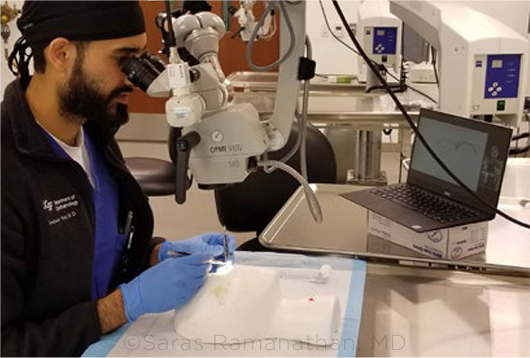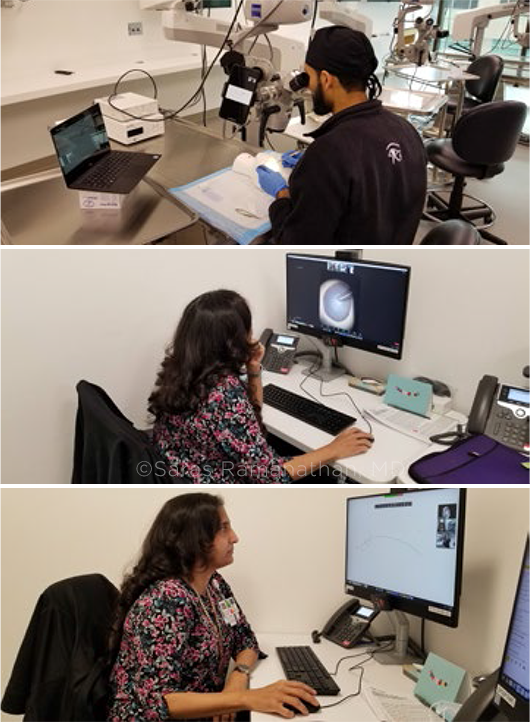Download PDF
A remotely monitored wet lab—created to teach microsurgical skills to residents during the COVID-19 lockdown—worked well enough to suggest that this model might be a widely applicable tool for ophthalmic education, researchers at the University of California, San Francisco (UCSF) reported.1
How it works. The Zoom-based system consists of a laptop computer to visualize the resident’s hand and body positioning, a smartphone attached to a standard operating microscope’s ocular with a smartphone camera adapter (Gosky Optics), and a large external monitor connected to the laptop. The latter enables the instructor to deliver information on a virtual whiteboard.
The multiple video images are then displayed side-by-side on the instructor’s home computer monitor.
 |
CREATIVE SOLUTION. The UCSF team developed the socially distanced wet lab after pandemic precautions eliminated conventional wet lab courses and curtailed surgeries.
|
Positive feedback. In a small prospective study, the researchers found that both the 10 residents and their three instructors rated the remote web lab as effective in teaching corneal suturing, and as equally or more effective compared to previous in-person wet labs. The setup allowed all features of the modified global rating scale of operative performance to be evaluated, the researchers said.
“From a teaching point of view, I was surprised at how effective this could be. And the fact that I could do this from my living room made me much more interested in and available for after-hours wet lab teaching,” said senior author Saras Ramanathan, MD.
 |
SETUP. In the wet lab (top), the smartphone, the microscope’s ocular, and the laptop can be seen. The instructor’s monitor (middle, bottom) shows the microscope’s view of the pig eye and the resident’s hand position and posture, as well as the whiteboard feature for drawing and teaching. The whiteboard is visible to the learner on the wet lab laptop.
|
Future applications. Dr. Ramanathan said she believes that remote sessions can never completely replace in-person instruction. However, the remote approach could augment ophthalmology residency programs in important ways, she said.
For residency programs. “Let’s say residents are about to go in to do their first corneal transplants, and they just want to make sure they do the suturing in the way their attending would like. This would be a great way to do one-on-one practice,” she said. “It’s an educational scaffold for those residents to learn the techniques that they will immediately be called upon to do at that next OR day.”
Remote wet labs also could benefit smaller training programs that have only one surgical microscope, because residents and instructors could schedule labs during off hours, Dr. Ramanathan said.
For those in practice. Similarly, a remote wet lab or other online tools might broaden the concept of continuing medical education for ophthalmologists already in practice, she said. “Zoom has made teleconferencing so second nature to all of us. I think there’s a lot of potential. We have to just think outside the box.”
Dr. Ramanathan added, “I wonder if we could do something like this to help ophthalmologists in private practice, in this country or in other countries, who are trying to learn new things and trying to get help from mentors who would otherwise be inaccessible. It seems reasonable to me that someday soon I could be here at my computer watching someone do surgery somewhere far away, and I could be helping them get through a case, just as I would help my resident in the OR.”
—Linda Roach
___________________________
1 Pasricha ND et al. J Cataract Refract Surg. 2020;46(12):1667-1673.
___________________________
Relevant financial disclosures—Dr. Ramanathan: None.
For full disclosures and the disclosure key, see below.
Full Financial Disclosures
Dr. Crama None.
Dr. Gillmann None.
Dr. Mansouri Allergan: S; ImplanData: C; Santen: C; Sensimed: C.
Dr. Ramanathan None.
Dr. Wong None.
Disclosure Category
|
Code
|
Description
|
| Consultant/Advisor |
C |
Consultant fee, paid advisory boards, or fees for attending a meeting. |
| Employee |
E |
Employed by a commercial company. |
| Speakers bureau |
L |
Lecture fees or honoraria, travel fees or reimbursements when speaking at the invitation of a commercial company. |
| Equity owner |
O |
Equity ownership/stock options in publicly or privately traded firms, excluding mutual funds. |
| Patents/Royalty |
P |
Patents and/or royalties for intellectual property. |
| Grant support |
S |
Grant support or other financial support to the investigator from all sources, including research support from government agencies (e.g., NIH), foundations, device manufacturers, and/or pharmaceutical companies. |
|
More from this month’s News in Review